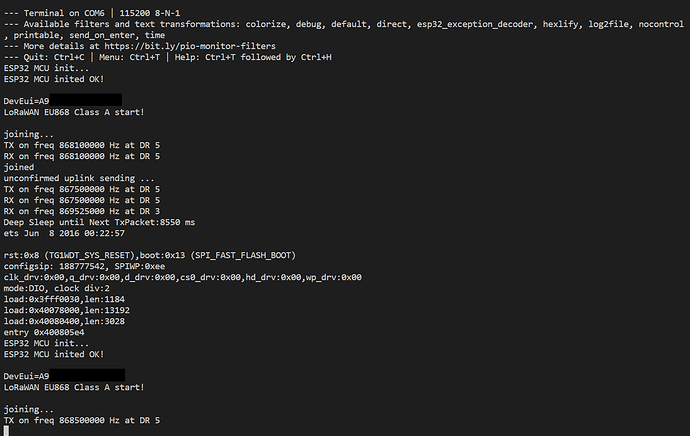I was checking if the crash problem that I have in my code is due to something in my code or in the library, I used the OTA example as a test to prove, however, the firmware crashes constantly after the MCU goes to sleep(after joining the network).
PlatformIO:
#include <ESP32_LoRaWAN.h>
#include "Arduino.h"
uint32_t license[4] = {0xxxxxxxxxx,0xxxxxxxxxx,0xxxxxxxxxx,0xxxxxxxxxx};
/* OTAA - Tes2 */
/* A9 20 21 AB C0 00 00 91 */
uint8_t DevEui[] = { 0xxx, 0x20, 0x21, 0xxx, 0xC0, 0x00, 0x00, 0xxx };
/* JoinEUI: AC 91 91 99 11 77 66 55 */
uint8_t AppEui[] = { 0xxx, 0x91, 0x91, 0x99, 0xxx, 0x77, 0x66, 0xxx };
/* 1A 7F 88 8B C6 37 2A 5A CA C1 7C C9 26 59 84 91 */
uint8_t AppKey[] = { 0xxx, 0x7F, 0xxx, 0x8B, 0xC6, 0x37, 0x2A, 0xxx,
0xCA, 0xxx, 0x7C, 0xC9, 0x26, 0x59, 0xxx, 0x91 };
/* ABP para*/
uint8_t NwkSKey[] = { 0x15, 0xb1, 0xd0, 0xef, 0xa4, 0x63, 0xdf, 0xbe, 0x3d, 0x11, 0x18, 0x1e, 0x1e, 0xc7, 0xda,0x85 };
uint8_t AppSKey[] = { 0xd7, 0x2c, 0x78, 0x75, 0x8c, 0xdc, 0xca, 0xbf, 0x55, 0xee, 0x4a, 0x77, 0x8d, 0x16, 0xef,0x67 };
uint32_t DevAddr = ( uint32_t )0x007exxxx;
/*LoraWan channelsmask, default channels 0-7*/
uint16_t userChannelsMask[6]={ 0x00FF,0x0000,0x0000,0x0000,0x0000,0x0000 };
/*LoraWan Class, Class A and Class C are supported*/
DeviceClass_t loraWanClass = CLASS_A;
/*the application data transmission duty cycle. value in [ms].*/
uint32_t appTxDutyCycle = 15000;
/*OTAA or ABP*/
bool overTheAirActivation = true;
/*ADR enable*/
bool loraWanAdr = true;
/* Indicates if the node is sending confirmed or unconfirmed messages */
bool isTxConfirmed = false;
/* Application port */
uint8_t appPort = 2;
/*!
* Number of trials to transmit the frame, if the LoRaMAC layer did not
* receive an acknowledgment. The MAC performs a datarate adaptation,
* according to the LoRaWAN Specification V1.0.2, chapter 18.4, according
* to the following table:
*
* Transmission nb | Data Rate
* ----------------|-----------
* 1 (first) | DR
* 2 | DR
* 3 | max(DR-1,0)
* 4 | max(DR-1,0)
* 5 | max(DR-2,0)
* 6 | max(DR-2,0)
* 7 | max(DR-3,0)
* 8 | max(DR-3,0)
*
* Note, that if NbTrials is set to 1 or 2, the MAC will not decrease
* the datarate, in case the LoRaMAC layer did not receive an acknowledgment
*/
uint8_t confirmedNbTrials = 8;
/*LoraWan debug level, select in arduino IDE tools.
* None : print basic info.
* Freq : print Tx and Rx freq, DR info.
* Freq && DIO : print Tx and Rx freq, DR, DIO0 interrupt and DIO1 interrupt info.
* Freq && DIO && PW: print Tx and Rx freq, DR, DIO0 interrupt, DIO1 interrupt and MCU deepsleep info.
*/
uint8_t debugLevel = LoRaWAN_DEBUG_LEVEL;
/*LoraWan region, select in arduino IDE tools*/
LoRaMacRegion_t loraWanRegion = ACTIVE_REGION;
static void prepareTxFrame( uint8_t port )
{
appDataSize = 4;//AppDataSize max value is 64
appData[0] = 0x00;
appData[1] = 0x01;
appData[2] = 0x02;
appData[3] = 0x03;
}
// Add your initialization code here
void setup()
{
Serial.begin(115200);
while (!Serial);
SPI.begin(SCK,MISO,MOSI,SS);
Mcu.init(SS,RST_LoRa,DIO0,DIO1,license);
deviceState = DEVICE_STATE_INIT;
}
// The loop function is called in an endless loop
void loop()
{
switch( deviceState )
{
case DEVICE_STATE_INIT:
{
LoRaWAN.init(loraWanClass,loraWanRegion);
break;
}
case DEVICE_STATE_JOIN:
{
LoRaWAN.join();
break;
}
case DEVICE_STATE_SEND:
{
prepareTxFrame( appPort );
LoRaWAN.send(loraWanClass);
deviceState = DEVICE_STATE_CYCLE;
break;
}
case DEVICE_STATE_CYCLE:
{
// Schedule next packet transmission
txDutyCycleTime = appTxDutyCycle + randr( -APP_TX_DUTYCYCLE_RND, APP_TX_DUTYCYCLE_RND );
LoRaWAN.cycle(txDutyCycleTime);
deviceState = DEVICE_STATE_SLEEP;
break;
}
case DEVICE_STATE_SLEEP:
{
LoRaWAN.sleep(loraWanClass,debugLevel);
break;
}
default:
{
deviceState = DEVICE_STATE_INIT;
break;
}
}
}
I know this library is deprecated now, but at least we should have the basic LoRaWAN functionality working as expected.
Thank you
Amir

